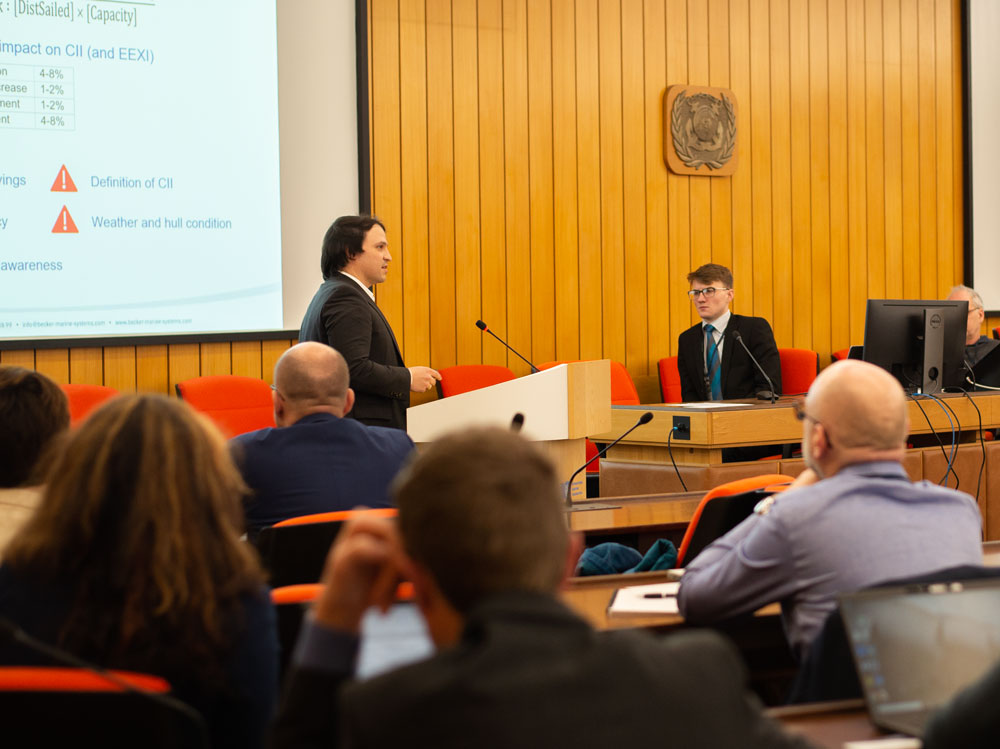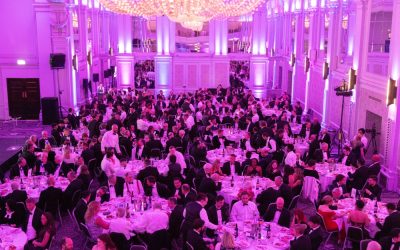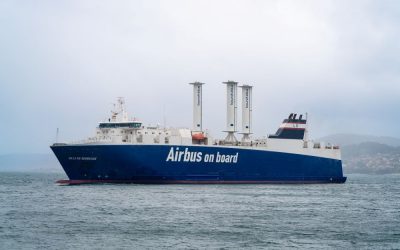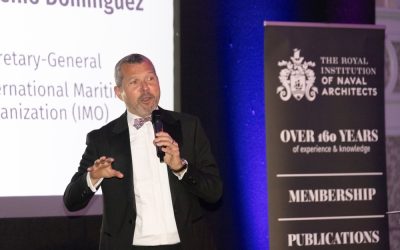As the RINA 2025 Technical Conference on Managing CII and Associated Challenges approaches, the maritime industry is gearing up for an exciting opportunity to delve into the latest developments in the CII. This event will bring together an exceptional line-up of speakers, offering valuable insights into the challenges and opportunities surrounding the industry’s transition to more sustainable practices.
Building on the momentum from the CII 2024 Conference, hosted by RINA at IMO Headquarters in London, this year’s conference will continue to shape the industry’s response to the evolving regulatory landscape. The 2024 event brought together over 90 stakeholders to review the first year of CII implementation, with discussions covering operational and technical strategies, new metrics and ship type-specific challenges. Insights shared during the conference have already influenced key decisions at IMO’s Marine Environment Protection Committee (MEPC) meetings, paving the way for the ongoing development of CII regulations.
The event is sponsored by Hempel, a global supplier in high-performance hull coatings. Hempel’s advanced coatings play a key role in optimising energy efficiency, reducing emissions, and enhancing vessel performance, making them one of the simplest and most effective ways to maintain a strong CII rating. With over 100 years of experience in the marine industry, Hempel delivers coatings designed to protect vessels in the harshest of conditions, while providing industry-leading fuel-saving and antifouling performance.
Attendees can expect a comprehensive programme that includes expert talks, dynamic panel discussions, and plenty of opportunities to network with industry professionals from across the globe.
Register here for the 2025 Technical Conference on Managing CII and Associated Challenges now to be part of this critical industry discussion.
As we look ahead to the conference, the presentations will provide in-depth insights into the various aspects of CII implementation and its wider implications. Each speaker will share their expertise on critical topics ranging from biofouling management to the role of data in ensuring CII reliability, offering attendees a comprehensive understanding of the challenges and potential solutions within the maritime sector. Below is a preview of the key presentations you can expect:
CII 2025 Conference Preview
Marine Environmental Metrics: Are we Measuring the Right Thing?
John Hatley, MARITEX:
This presentation illuminates’ insights that emanate from historical reference to Peter Drucker’s insightful statement: “You can’t manage what you can’t measure.” This principle has a significant impact on maritime emissions reduction today, much like it did when it was first articulated. To meet IMO emission reduction goals, we need to implement valid measures that enable us to manage this process effectively, ultimately working towards preserving our planet for future generations. Key takeaways include: How does the CII, as an ‘operational measure’ influenced by the realities of commerce, conflict with technical ‘design measures’? Attendees will gain several insights into how this conflict often leads to unintended consequences that undermine efforts to reduce emissions.
Balancing Energy Efficiency and Marine Biodiversity in the Decarbonization Era
Yigit Kemal Demirel, Hempel A/S:
As the shipping industry races to meet decarbonisation targets, effective biofouling management plays a crucial role in reducing fuel consumption and GHG emissions while safeguarding marine biodiversity. Our presentation emphasises the importance of balancing trade-offs in biofouling management between emissions to air (reducing fuel consumption and GHG emissions by maintaining clean hulls) and emissions to water (passive or accelerated release of waste substances to ensure clean hulls). We will explore how different biofouling management strategies may impact fuel savings, CII compliance and the water column through emissions from coatings and in-water cleaning. Using simulation-based insights, we will reveal the unintended consequences of conventional practices and propose a more holistic, sustainable approach to biofouling management. This presentation is crucial for maritime professionals looking to understand how high-performance coating solutions can help vessels meet CII requirements while maintaining operational efficiency and sustainability.
The Importance of Data Scope and Reliability for The Robustness and Acceptability of The Ship Carbon Intensity Indicator (CII)
Peyman Ghaforian Masodzadeh, World Maritime University:
In order to achieve shipping decarbonization, it is essential that a well-recognized and credible CII be established, approved by all stakeholders. Relevance (scope) and reliability of the data, feeding the CII, are of paramount importance.
Several concerns exist regarding the reliability of data, including the possibility of data manipulation, the quality of data verification, the disclosure and transparency of data, and the role of flag states.
Our findings show that most stakeholders prefer the EEOI, in comparison to AER. According to our findings, stakeholders believe that disclosure of actual cargo tonnage (eg, in EEOI calculations) is not commercially sensitive, as long as confidentiality clauses (between ship operators and verifiers) are in place.
The future of CII in the well-to-wake fuel chain
Jan-Erik Rasanen, Foreship Ltd
As IMO formulates mid-term measures to promote the use of zero- and low-emission fuels from 2027, Foreship’s presentation will draw on the company’s vast experience of assessing ship performance for the CII. It will examine how a possible change from the CII’s current ‘tank-to-wake’ to a ‘well-to-wake’ approach with the FuelEU Maritime regulation will impact the CII, and how the IMO can formulate a workable indicator towards measuring carbon content in fuel in this way.
eSAILs©: using wind to improve real vessel CII and environmental performance
Simone Saettone, bound4blue:
Our presentation showcases how bound4blue’s eSAIL® technology is advancing maritime sustainability by leveraging wind-assisted propulsion to enhance both operational efficiency and environmental performance. Unlike traditional sails, the eSAIL® functions as an active aerodynamic device, optimizing lift generation through integrated suction mechanisms that manipulate the boundary layer on the sail’s surface. This advanced system sets a new standard for performance among wind-assisted propulsion systems (WASP), achieving a potential angle of attack of 50–60°, and offering the ideal balance between efficiency and adaptability.
The potential of the eSAIL® system was evaluated through a case study involving the retrofitting of four eSAIL® units on the chemical tanker Bow Olympus. The analysis demonstrates that the eSAIL® system enables the vessel to maintain a B Carbon Intensity Indicator (CII) rating from 2024 to 2026, effectively avoiding a downgrade to D by 2029 under progressively stricter regulatory requirements.
These findings highlight eSAIL®’s ability to align environmental sustainability with regulatory compliance, reduce reliance on fossil fuels, and enhance operational resilience. With its modular design, autonomous operation, and flexibility for retrofitting or integration into newbuilds, eSAIL® offers a scalable and cost-effective solution for advancing maritime decarbonization.
Evaluation on Energy Savings Effect of Corrective Actions Using Monitoring Operational Data for Ferries
Toshiyuki Kano, NPO Marine Technologist:
Reduce the environmental impact of ship operations, various corrective actions are being taken on ships to improve energy efficiency. Improvement effects of corrective actions are evaluated based on measured fuel oil consumption (FOC), but actual FOC measurements vary widely and appear to be difficult to organize and evaluate successfully. In this paper, we propose the EENI Energy Efficiency Navigational Index), which is fuel consumption per ton of displacement and mile of voyage, as operational energy efficiency. And, for ferries, we assumed a Winner-type stochastic process model regarding the operational energy efficiency of each voyage and proposed a methodology to accurately compare and evaluate the energy efficiency during operation and the improvement effects of corrective measures. The significance level of the improvement effect can be confirmed using a statistical test method. The proposed method was applied to an actual ship, and the energy efficiency during operation using CII and EENI and the energy efficiency improvement effect when using WR as a corrective measure were confirmed, and their significance level was compared and evaluated. Furthermore, based on operational data, we will show the factors behind why the use of WR resulted in energy savings. This allows us to consider possible actions for further improvement. The proposed methodology allows for a highly accurate evaluation of the energy efficiency of the operation and the effectiveness of the corrective actions. Sharing our experience will contribute to the consideration of CII.
Operational techniques for CII voyage score enhancement in WASP fitted ships
Konstantinos Fakiolas, FINOCEAN LTD:
Wind-assisted ship propulsion can provide a great capability for significant CII score improvement for all ships, once the actual factors that impact the real voyage carbon intensity are taken into account.
Specific operational techniques related to the voyage, propulsion integration and incoming wind management can improve performance when managed and harmonised appropriately.
It will be demonstrated to the audience how WASP operational optimization when applied to ships with long sailing time can support compliance with the forthcoming stricter CII reduction limits, especially as foreseen beyond 2026. Case study examples will be presented on a couple of representative benchmark cargo ships fitted by WASP units and practical guidelines will be provided for operational CII optimisation.
Onboard Energy Data as the Key to Operational Optimization and Reporting
Uwe Altenbach, Hoppe Marine GmbH:
The integration of precise sensors and timeseries data acquisition through the Maritime Internet of Things (MIoT) paves the way for effective energy balancing and operational optimization.
This approach requires a holistic acquisition of energy and emission-relevant data, such as flow meters, shaft torque meters, measurement of electrical consumers and, finally, the recording of nautical and weather data to be able to check the plausibility of this data.
In addition to the focus on high-precision and reliable sensor technology, a cyber-secure and robust data connection to a cloud storage is utilised to grant access this data for all parties, involved in the further analysis. An important intermediate step is the application of smart math-based algorithms, methods and not least expert knowledge to analyse the measurement data in terms of its quality. ensuring that this measurement data provides a reliable basis for any further analysis and decision-making.
Hoppe Marine thus offers a holistic system solution to provide highly accurate measurement data for compliance with the CII guidelines and to prepare for the challenges of the EU ETS and Fuel EU.
This is the enabler for any operational optimisation and validated reporting solutions and demonstrates the critical role of data-driven decision making and reporting in achieving sustainability and efficiency improvements.
Blue Visby: Collaborative Arrival Optimization as a Pathway to Carbon Reduction
Haris Zografakis, Blue Visby Consortium Co-ordinator:
The single largest systemic carbon inefficiency in maritime trade is the so-called “Sail Fast, Then Wait” practice, where ships sail at their service speed towards a congested port, only to wait at the anchorage. SFTW is encouraged by the structure of maritime contracts and there can be no solution by technology alone.
SFTW stands in the way of decarbonization in relation to the carbon intensity of today’s fleet, and will also hinder the adoption of alternative fuels, due to their cost, scarcity and low energy density. Addressing SFTW is as important and urgent as any other aspect of decarbonisation.
Attempts to overcome SFTW through Virtual Arrival since 2008, or Just-in-Time berthing systems, have been sporadic and limited to narrow applications. By contrast, the systemic approach of the Blue Visby Solution presents a unified core solution that can be applied to any type of berthing model: First-Come-First-Served, or berthing based on cargo terminal stem, or berthing dictated by port authorities.
The project, supported by the 42+ members of the Blue Visby Consortium, represents the most comprehensive attempt to mitigate the effects of SFTW, having conducted the most detailed studies, hindcast simulations, pilots and trials.
Beyond Carbon Intensity: Enhancing GHG Reductions through an effective EE metric and Regulatory Alignment
Daniel Barcarolo, The Mærsk Mc-Kinney Møller Center for Zero Carbon Shipping:
The presentation will focus on providing insights on the outcomes of the project carried out by MMMCZCS in identifying how to improve the short-term measures and in particular the Carbon Intensity Indicator to drive a higher uptake of energy efficiency and meet the IMO GHG Strategy Targets. Based on extensive data set collected via the Center partnership, the project developed a set of solutions to improve the CII, passing by a change of metric and a change of enforcement mechanism for the CII. These proposed changes can provide the industry with the appropriate regulatory framework to drive the uptake of energy efficiency actions.
Effective Biofouling Management Strategies: The Challenges With Ship-Specific Functional Specifications and Coating Selection
Ralitsa Mihaylova, Safinah Group:
Effective biofouling management strategies – including hull coating specification, selection and potential in-water cleaning regimes, are energy efficiency levers that require relatively low initial investment, but their effectiveness hinges on appropriate planning. Best practice requires a ship-specific approach to biofouling management, however, the number of commercially available hull coatings and emerging in-water cleaning equipment as well as the lack of data on the in-service performance of these systems and their ’compatibility’ hinder informed decision-making. This talk aims to highlight some of the challenges with hull coating specification & selection with the help of case studies and to suggest practical solutions for avoiding common pitfalls based on experience from 700+ technical coating specification reviews and hull coating performance data from 900+ dry dock projects.




